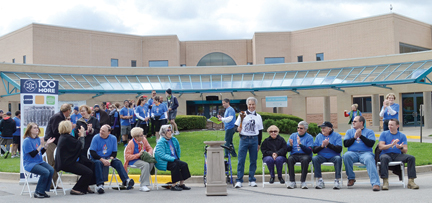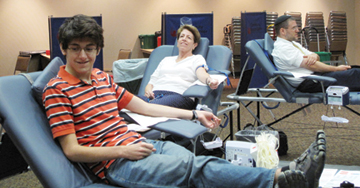 The Jewish Community Campus opened to a grand celebration 25 years ago on Oct. 30, 1988. The anniversary passed quietly last week with no hurrahs, no special festivities. But it was business as usual and on the exact date of the anniversary, Oct. 30, 2013, a panel discussion took place bringing members of the community together in just the way the planners had envisioned.
The Jewish Community Campus opened to a grand celebration 25 years ago on Oct. 30, 1988. The anniversary passed quietly last week with no hurrahs, no special festivities. But it was business as usual and on the exact date of the anniversary, Oct. 30, 2013, a panel discussion took place bringing members of the community together in just the way the planners had envisioned.
“Bringing our Jewish community together and making it more cohesive are the underlying motives for the Campus undertaking,” wrote Rabbi Morris Margolies in October 1988 in remarks published in The Chronicle’s Commemorative Campus Issue. As rabbi emeritus at Congregation Beth Shalom, he was the community’s senior rabbi at the time the Campus was built.
During the early 1980s, leaders of the Jewish community began discussing the idea of bringing the Jewish Community Center, the Hyman Brand Hebrew Academy and the agencies led by the Jewish Federation together in one place.
“We saw there was a need for a place for Jewish identity and participating for those who didn’t belong to Jewish country clubs,” George Lieberman was quoted as saying in a 1988 Chronicle article. At the time he served on the JCC board and was active in getting the Campus up and running, eventually serving as president of its board.
“By having a campus, we would be able to interrelate all the agencies to the Jewish community to provide the services which are needed,” Lieberman said at the time.
Members of four extended families donated the land for the Campus: Rose Morgan, Frank Morgan, Irene and Sherman Dreiseszun; Rita and Irwin Blitt, Bunni and Paul Copaken, Shirley and Lewis White; Sarah Ozar and Dorothea and Nathan Jagoda; and Lewis and Bessie Goldberg, Stan and Gerry Goldberg, and Phyllis and Irv Maizlish. Each of these families still has a representative on the Campus board of directors.
As Sol Koenigsberg, the executive director of the Jewish Federation when the Campus was built, noted in his 2012 book “Challenges and Growth, The Jewish Federation of Greater Kansas City, 1968-1989,” not everyone was in favor of a campus concept in the beginning.
“As progress was being made in planning and fundraising, a vocal minority expressed concern that a ghetto was being created. After a history of assimilation and of keeping a low profile, they felt that we were going to be seen as isolating ourselves from the general community. After the Campus was built, many of those who had held that opinion began to accept the Campus as a unifying entity. The vocal minority ranks diminished but has not completely disappeared,” Koenigsberg recalled.
‘A remarkable achievement’
Koenigsberg believes the creation of the Campus was a remarkable achievement.
“No one person should take credit for the concept of housing agencies in one building. It was a coincidence that the Jewish Community Center and the Hebrew Academy both needed a new facility at the same time. The Jewish Family and Children’s Service and the Central Agency for Jewish Education also needed to be relocated. It was readily understood that raising multiple capital fund campaigns at the same time was not practical nor was it reasonable,” Koenigsberg wrote.
Scott Slabotsky, who has been involved with the Campus since its inception as well as its largest tenant, the Jewish Community Center, since 1984, thinks the Campus has “worked out great.”
“I think it’s the jewel of the Kansas City Jewish community. It’s the single place that members of any congregation or unaffiliated can go regardless of their Jewish connection,” Slabotsky said. “It’s the only building that exists in this community where all ages can go for some benefit whether it’s socialization, cultural arts, education, athletics, tennis, swimming … we are so fortunate to have a facility like this in the community.”
 The original 224,000-square-foot building cost $22 million to build and housed the Jewish Community Center — including its preschool, the Child Development Center, and its fitness facility — and the Hyman Brand Hebrew Academy. Those tenants alone occupy about 82 percent of the square footage. The other occupants included the Jewish Federation, Jewish Family Services, CAJE, Jewish Vocational Services, Jewish Community Foundation, Jewish Community Relations Bureau|American Jewish Committee and Menorah Medical Center. Menorah moved out after a few short years and the Midwest Center for Holocaust Education took over the space. Today St. Luke’s Health System also rents space in the Campus lobby.
The original 224,000-square-foot building cost $22 million to build and housed the Jewish Community Center — including its preschool, the Child Development Center, and its fitness facility — and the Hyman Brand Hebrew Academy. Those tenants alone occupy about 82 percent of the square footage. The other occupants included the Jewish Federation, Jewish Family Services, CAJE, Jewish Vocational Services, Jewish Community Foundation, Jewish Community Relations Bureau|American Jewish Committee and Menorah Medical Center. Menorah moved out after a few short years and the Midwest Center for Holocaust Education took over the space. Today St. Luke’s Health System also rents space in the Campus lobby.
Alan Bram, who was hired in 1987 to run the Campus and served as its helm until earlier this year, said, “The comprehensive Campus facilities provided the Jewish Community Center and Hyman Brand Hebrew Academy the special spaces they needed. Clean up-to-date office and program space was now available for all the tenant agencies.”
Until the theater wing was built nine years ago, many thought something was lacking.
“If you didn’t exercise there because you had a fitness center close to your house or you didn’t have kids in the preschool or the Hebrew Academy, there was no real piece of the Campus that could attract people of all ages at one time,” Slabotsky noted.
“When we created the design to build the theater 11 years ago and opened the theater in October of ’05, the Campus truly, in my opinion was completed. When I walk out of the theater on a Saturday night and see people of all ages … children and grandparents seeing a production … they all have options to go all kinds of other places and now you see hundreds and hundreds of people walk out of the Campus theater on a Saturday. That just warms my heart,” said Slabotsky, who has served a term as Campus president, was its treasurer for 15 years and has rarely missed a board meeting in 20 years.
In addition to the Lewis and Shirley White Theatre, the expansion includes space for the Heritage Center with its own kitchens as well as office space for the Jewish Community Foundation and JCC staffers and more meeting space.
A model for other communities
Bram said today the Campus is the focal point of the community.
“It is full of the hustle and bustle of participants of all ages taking advantage of expanded programming and services. Collaboration among agencies has become a reality providing for program growth while eliminating duplication,” Bram said. Dan Cullinan began running the Campus this summer.
Alan Edelman, the Jewish Federation’s associate executive director was the director of what was then known as the Jewish Education Council when plans for the Campus began taking shape. He is one of the few Jewish communal professionals who has worked in the building for its entire existence. He said planning for the building, before they even put a shovel in the ground, was very exciting.
“Before the Campus opened there were some examples of collaboration. But when you are under the same roof, it’s a lot easier to do programming and to meet professional-to-professional to come up with programs. It’s just a lot easier. That’s the most significant thing about being in this building,” Edelman said.
He can point to many examples as to why the Campus, and all the collaborative program it has spurred, has succeeded in its mission to bring people together.
“When you want to do a program for adults and you can offer babysitting for their children because you’ve got a great facility at the Campus through the JCC, that makes things really convenient,” Edelman said.
“Examples like that can be multiplied many times. For instance if the Academy or the CDC want to do multi-generational programming, you’ve got the Heritage Center here,” he continued.
Bram noted that the Campus was bringing people together even before it opened.
“The opening of the building brought the community a sense of pride and accomplishment. There were over 400 volunteers and staff involved in planning and overseeing the construction of the Campus, which was the first of its size in the country. It became a model for others to emulate,” he said
After 25 years, Slabotsky said it is still viewed as a model by other Jewish communities.
“We are still talked about in other cities. Houston, St. Louis and Salt Lake are my most recent conversations in my travels and it allows me to continue to be proud of what we have accomplished in Kansas City,” Slabotsky said.
Current Campus President Greg Wolf, who began his term Oct. 1, said when it comes to funding, the Campus is very secure.
“John Rubenstein raised a substantial sum during his tenure as president (which just ended) and we are on very stable financial footing,” Wolf said.
Over the years the Campus board has worked hard raising money and creating funds that can be used when money is needed for capital expenditures, Wolf explained.
“For example we just put a new roof on in the last two or three years and those are the types of expenses that you have to deal with with a building that’s 25 years old. We have absorbed those costs. The goal is to provide a positive place for all these agencies to be so their synergy is there and our goal is also to try to keep the cost of those agencies being there as low as possible,” Wolf said.
Slabotsky points out that the building has been very well maintained.
If you go to the Campus right now you could not tell that it’s 25 years old,” Slabotsky said.
Twenty-five years after it opened, Slabotsky is very glad the Campus was built.
“I could not imagine this community not having this.”



